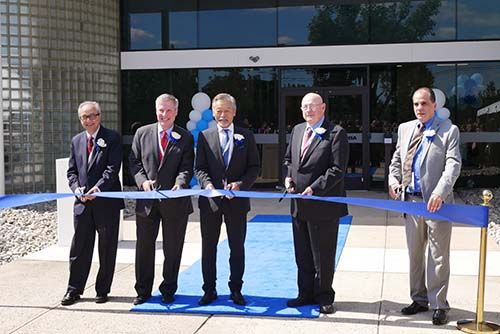Horiba Scientific Celebrates New Facility Opening
Horiba Scientific recently celebrated the official opening of its new facility in Piscataway, New Jersey.
Horiba Scientific recently celebrated the official opening of its new facility in Piscataway, New Jersey. Horiba executives, including Atsushi Horiba, the company’s chairman. Also joining the celebration were local celebrities Senator Bob Smith, Piscataway Mayor, Brian Wahler, and leaders from industry and academia were in attendance.
Ribbon cutting ceremony on August 31, 2018, at Horiba Scientific's new facility in Piscataway, New Jersey.

The 132,000-square foot facility has an open office design that includes natural light, open communication spaces, informal work areas, and conference rooms for meetings and global video conferences. A tour of the facility highlighted office, engineering, manufacturing, laboratory, and cleanroom spaces, including more than 6400 square feet of applications laboratories designed to showcase the company’s product line, applications training capabilities, method development, and product demonstrations.
Four laboratories are designed around specific sciences: earth science, life science, materials science, and industrial science. Each laboratory reportedly specializes in the sample preparation, analysis, and data reporting appropriate for those techniques and their unique requirements; each is equipped with core instruments from various product lines that exemplify the techniques and measurements relevant to the application space. The laboratories are used for sales demonstrations, training, customer support, engineering validation, and basic research. Training centers, adjacent to the laboratories, can be used for customer training and service training for the global network of affiliates and distributors.
The move allows for the original equipment manufacturer (OEM) facility to be located in the same building as the main office. The OEM facility has dedicated research and development (R&D) and manufacturing space, including several cleanrooms to meet production requirements.
The tour concluded with instrument and poster displays of the five Horiba segments (corporate, medical, semiconductor, automotive, process, and environmental) outside the lunchroom, followed by a buffet lunch and the cutting of a ceremonial seven-layer cake representing the color spectrum.
Horiba Scientific, part of Horiba Instruments Inc. and headquartered in the United States, provides instruments and solutions for applications across a range of scientific R&D and quality control measurements. The company provides OEM spectroscopy, elemental analysis, fluorescence, forensics, glow discharge spectroscopy, inductively coupled plasma spectroscopy, particle characterization, Raman, spectroscopic ellipsometry, Sulphur-in-oil, surface plasmon resonance imaging, water quality measurements, and X-ray fluorescence spectroscopy.
Spectroscopy and GPC to Evaluate Dissolved Organic Matter
February 4th 2025In a new study, a team of scientists used gel permeation chromatography, three-dimensional excitation-emission matrix fluorescence spectroscopy, and UV-visible spectroscopy to assess road runoff from drinking water treatment plants to evaluate the method' capacity for removing dissolved organic matter (DOM).
Blood-Glucose Testing: AI and FT-IR Claim Improved Accuracy to 98.8%
February 3rd 2025A research team is claiming significantly enhanced accuracy of non-invasive blood-glucose testing by upgrading Fourier transform infrared spectroscopy (FT-IR) with multiple-reflections, quantum cascade lasers, two-dimensional correlation spectroscopy, and machine learning. The study, published in Spectrochimica Acta Part A, reports achieving a record-breaking 98.8% accuracy, surpassing previous benchmarks for non-invasive glucose detection.
Distinguishing Horsetails Using NIR and Predictive Modeling
February 3rd 2025Spectroscopy sat down with Knut Baumann of the University of Technology Braunschweig to discuss his latest research examining the classification of two closely related horsetail species, Equisetum arvense (field horsetail) and Equisetum palustre (marsh horsetail), using near-infrared spectroscopy (NIR).